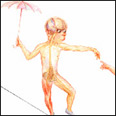|
Human Physiology in Space
In some of his most recent work, Bartner created illustrations for the
textbook Human Physiology in Space , produced jointly by the National
Aeronautics and Space Administration (NASA), NIH, the Universities Space
Research Association, and the University of Texas Southwestern Medical
Center. The textbook uses space science to inspire high school students
to learn about human physiology. Bartner invented two characters, a teenage
boy and girl, to demonstrate the ideas in the text; his whimsical drawings
keep students involved.
Drawing 1: Boy on a Tightrope
Bartner's drawing of a teenage boy walking a tightrope shows how the body's
sensory organs work together with the bones and muscles to maintain balance,
keeping the boy from falling off the rope. Bartner incorporated Michelangelo's
famous Sistine Chapel painting of Adam's birth at God's hand (right side
of the drawing). "For me, the drawing also suggests the fragility
of life," says Bartner.

Drawing 2: The Inner Ear
In this series of drawings, Bartner shows in increasing detail the vestibule
organs of the inner ear responsible for balance. The three curved canals
of the inner ear detect when the head rotates, and the two small organs
they join (the otolith organs) detect when the head moves linearly. That's
why an infection in your inner ear may affect your balance.
Back To Top | Photography
Credits
Related Links
National
Aeronautics and Space Administration
Universities Space Research Association
University of Texas Southwestern
Medical Center
|


